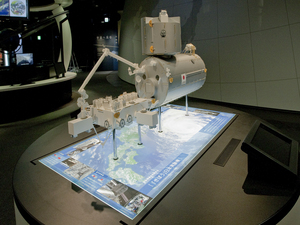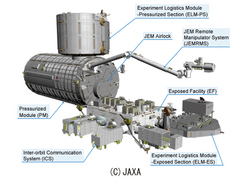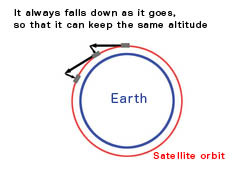Nagoya City Science Museum
TOP > Exhibition Guide > Keyword Search > Starting with "K" > Kibo > The Japanese Experiment Module "Kibo"
The Japanese Experiment Module "Kibo"

Purpose of Exhibition
The International Space Station is orbiting the earth at an altitude of about 400km.
The Japanese experiment module "Kibo" is connected to it.
This exhibit presents a 1/10 model of "Kibo", and an experiment performed in the microgravity and high vacuum environment of space. Also, the manufacturing techniques, which make astronauts feel safe when experiments are being conducted in the laboratory "Kibo", will be introduced.


Additional Knowledge
[Manufactured in the Nagoya Area]
The structural part of the on-board lab in "Kibo" and its storage room was manufactured in the factory of the village of Tobishima, Nagoya, Aichi Prefecture. This is situated on the other side of the Kinjyo Wharf, Nagoya Port.
Because ships can be docked on the premises of the factory, large equipment produced can be directly loaded on large vessels and transported.
The design of "Kibo" began with the National Space Development Agency (NASDA), the predecessor of the Japan Aerospace Exploration Agency (JAXA).
The on-board laboratory installed equipment was brought to the Tsukuba Space Center in September 2001 for comprehensive system testing.
After that, it departed for the Kennedy Space Center, Aeronautics and Space Administration (NASA) in May 2003.
After passing the inspection from NASA, it was launched with the space shuttle in June, 2008.
The on-board storage room was taken to the Tsukuba Space Center in May 2000 after leaving the port of Nagoya. It was launched by the space shuttle in March 2008 prior to the one with the on-board laboratory, and connected to the space station.
[Kibo's Structure]
"Kibo" is Japan's first manned space facility.
It is the largest experiment module in the International Space Station, which consists of two experiment spaces, an on-board laboratory and out-board laboratory platform. The on-board laboratory is 11.2 meters in length, and 4.4 m in diameter. The internal pressure is kept at 1 atm, so the astronauts can work in everyday on-board clothes. In the on-board laboratory, scientific experiments are implemented using cosmic radiation and microgravity with experiment racks. Furthermore, the out-board platform is directly exposed to space, and experiments in space, astronomical, and Earth observations can be carried out.
[Zero Gravity]
It is said that "There is Zero Gravity in Space", but this is not an entirely correct expression. Gravity is determined with the gravitational mass of two objects (weight) and its distance. It can go about as far as some 100km from the ground with a rocket into space. (Approximately 400km from the ground to the International Space Station) The Earth's radius is 6400km. Although going 400km from the earth to space, it is only about 6800km from the center of the Earth. Because there is not much difference in distance from the earth, the gravity difference is not that great. Rockets reach space at high speed and continue to orbit the Earth while maintaining speed. When advancing parallel to the surface at about 8 kilometers per second, the distance which rockets fall by gravity in a constant period of time and the length which the surface bends with the Earth's roundness are the same. Thus, as the rockets actually keep falling toward the Earth, they do not drop onto the surface and can continue revolving around the Earth. The International Space Station and satellites keep rotating around the Earth like this. Continuing falling not against gravity, there is no effect inside the space station and the satellites, which indicates "Gravity Free = Zero Gravity". In fact, because a little gravity is applied, it can be called "Microgravity".
Unlike on the ground, neither heavy matter nor light matter is applied gravity. Therefore, mixing materials with different weight, a homogenous mixture can be made.
<Cosmic Rays>
At the beginning of the 20th century, Hess discovered cosmic rays with high-energy radiation flying in space during the balloon observation.
Because the earth is covered with air, cosmic rays collide with molecules and atoms in the atmosphere and are transformed into secondary cosmic rays. The secondary cosmic rays also collide with atoms and molecules and few rays can reach the ground. The cosmic rays in space can be observed in the space station.
<Experiments in "Kibo">
The experiments with space environment are conducted in Kibo. There are a number of different fields covered, such as science, applied and others such as out-board platform.
Regarding the science field, research on material science and life science is carried out, while in the applied field, research applicable to product development on Earth is conducted. Themes of experiment are sought publicly and are determined by selection. In addition, ideas regarding arts and social science are also sought.
Cooperation:
Japan Aerospace Exploration AgencyArticle by Masao Suzuki, curator
